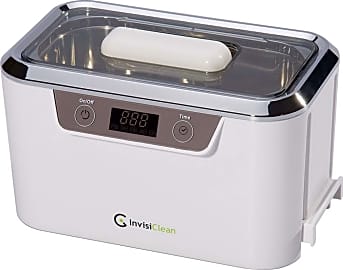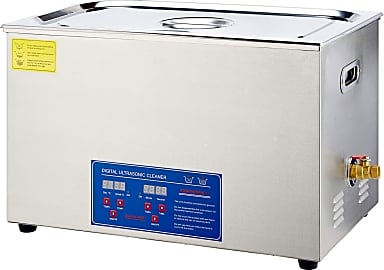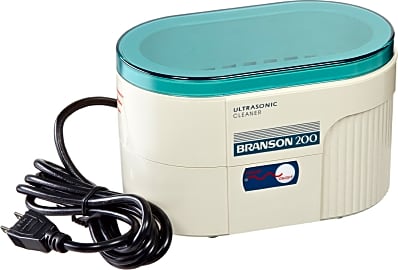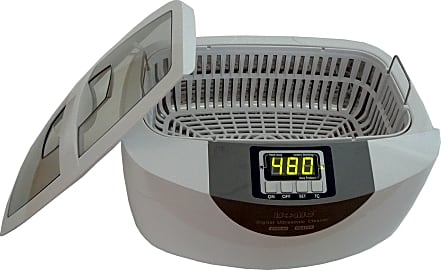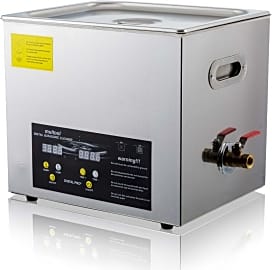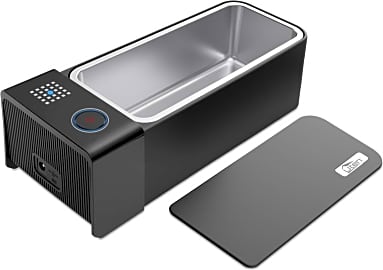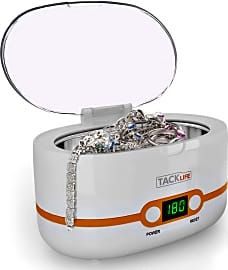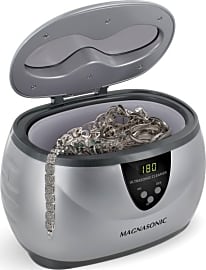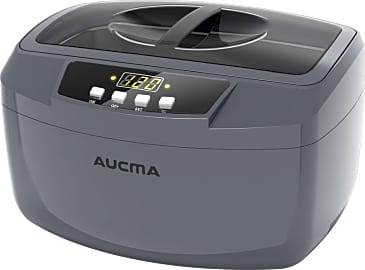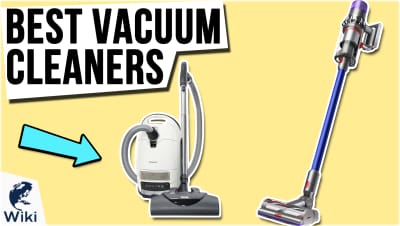The 10 Best Ultrasonic Cleaners

This wiki has been updated 40 times since it was first published in June of 2015. Sonic waves have all kinds of useful properties, including the ability to scrub items thoroughly without chemicals. Our selection of ultrasonic cleaners includes industrial and consumer models that are ideal for maintaining jewelry, dental equipment, tattoo needles, and even sensitive items, like CDs and DVDs. Just make sure to familiarize yourself with which things can and cannot be cleaned. When users buy our independently chosen editorial picks, we may earn commissions to help fund the Wiki.
Editor's Notes
November 05, 2020:
Ultrasonic cleaners are a quick and efficient way to remove dirt and grime from a variety of items, though it is important to understand what kind of things can and cannot withstand ultrasonic vibrations without being damaged, so it is vital that you do a little research before just dropping valuable or fragile items into one of these units. Some examples of items that should not be put inside an ultrasonic cleaner are emeralds, opal, pearls, coral, ivory, and amber. Conversely, very hard gemstones like diamonds, sapphire, and rubies should be fine, as are most precious and industrial metals.
It is also important to understand which frequencies are better suited to certain uses. Contrary to what one might immediately assume, higher frequencies are less harsh and better for fragile items or those with very tiny crevices, whereas lower frequencies are going to be more aggressive and not as well suited to delicate things. Applying that information to some of the models on the list, we can see that the H&B Luxuries Industrial 160 and iSonic Professional P4820, which both produce a 35-kilohertz frequency are going to be a good choice for more durable items, whereas the Branson B200 and Uten MK-186, which produce a 55- and 50-kilohertz frequency, respectively, are going to be safer for fragile items or those that have a lot of very tiny cracks and crevices. Models like the CO-Z 30L and Kaimashi QXJA are between those two extremes, which can make them slightly more versatile.
Home users who only plan on cleaning jewelry, glasses, and similarly compact items will usually be best served by a small model that is easy to hide out of the way when not in use, such as the InvisiClean IC-2755, Branson B200, Tacklife MUC02, and Magnasonic MGUC500, though it is worth noting that these last two don't have heat. For a consumer that may want the ability to clean some larger items too, like silverware, or the ability to clean a lot of little items in one cycle, like ammo casings or engine components, may prefer something with a more moderate capacity, such as the H&B Luxuries Industrial 160 or iSonic Professional P4820.
For industrial uses, we highly recommend the CO-Z 30L and Kaimashi QXJA, not only for their large capacities, but also for their tough stainless steel construction.
November 25, 2019:
Due to a malfunction that can cause sparking and smoking, we noted that the Famili Polisher was a potential fire hazard, so we took it off the list. We removed a couple other models after discovering significant quality concerns as well.
People use the iSonic Professional for cleaning ammunition, hair clipper blades, diamonds, eyeglasses — you name the item, and this unit seems to do a solid job removing dirt and grime. We also noted that it doesn’t generate a ton of noise. We moved this one up in the rankings.
The Tacklife MUC02, on the other hand, isn’t as quiet as the iSonic model, but it’s a serviceable low-cost option for personal use at home. We pointed out that the H&B Luxuries Industrial is a favorite of firearm owners who require an efficient way to clean small, intricate parts.
Special Honors
JorVet J0382A This unit is designed for the veterinary industry, but that doesn’t mean it won’t prove advantageous for other applications as well. Its advanced scrubbing power, crated by its heavy-duty, industrial-grade transducer, allows it to penetrate tiny cracks, tight grooves and hard-to-reach areas that you’d never be able to access by hand. jorvet.com
SRA TruPower The TruPower line of ultrasonic cleaners contains everything from small, efficient models that require very little power to operate to industrial-sized options with huge tanks that can accommodate all kinds of dirty gear. Conveniently, many of them have a memory function to save settings from batch to batch, helping to save time on the job. sra-solder.com
How Ultrasonic Cleaners Work
The higher the frequency used to create these mini vacuums, the smaller the nodes between cavitation points and the further the cleaning power can reach into minute crevices.
Ultrasonic cleaners use ultrasound technology and either water or a specialized cleaning solution to clean and sanitize a variety of items ranging from jewelry to medical tools to electronic equipment. Most often they operate in frequencies ranging from 20 - 400 kHz. Depending on the efficiency of the transducer and the items being cleaned, cleaning can last anywhere from 3 to 30 minutes, with most cycles ranging from 3 to 6 minutes.
Once an item is inserted into the cleaning chamber and it is filled with a suitable liquid, generally a solvent, the device is powered on. An ultrasound generating transducer then creates ultrasonic waves by changing size in concert with an electrical signal, which is oscillating at an ultrasonic frequency. This causes thousands of minuscule compression waves in the liquid, which are essentially tearing the liquid apart and creating millions of microscopic vacuum bubbles in a process called cavitation.
Once formed, these bubbles are not stable and collapse in on themselves with enormous energy producing upwards of 20,000 lbs. of pressure per square inch and 5,000 kelvins of heat. These bubbles are small enough that they don't harm the item being cleaned, but have the power to remove surface dirt and other contaminants. The higher the frequency used to create these mini vacuums, the smaller the nodes between cavitation points and the further the cleaning power can reach into minute crevices.
Since ultrasonic cleaners are using the incredible power produced as a side effect of cavitation, they don't require the harsh cleaners often used in most industrial cleaning applications.
History Of Ultrasonic Cleaning
While the inception of ultrasonic cleaning goes back to the early 1930s, it wasn't pursued as a cleaning method until the 1950s. The technology was discovered by accident when one of RCA's labs used Freon to cool some internal components of a radio. They noticed that a wave action surrounded one of the crystals, which was operating at 300 kHz.
They noticed that a wave action surrounded one of the crystals, which was operating at 300 kHz.
Later on, in the 1950s, companies began the development of ultrasonic cleaners in earnest and started to sell them for use in industrial cleaning applications. Most of the systems developed at this time operated in the 18 kHz to 40 kHz frequency range.
Despite the fact that we use ultrasonic cleaners that are able to create much higher frequencies now, the cleaning power created at even these low levels was astounding. In the mid to late 1970s, the technology used to create ultrasonic cleaners began to drop in price and lower cost models intended for home use appeared on the market.
Until the late 1980s, the majority of home and industrial ultrasonic cleaners continued to operate at 40 kHz or less. Over the last thirty plus years, advances in transducer technology has allowed companies to make incredibly powerful units that are still small in size, with the majority of the advances happening in the last ten years.
The most recent advances in ultrasonic cleaning have focused on creating a range of frequencies, either simultaneously or consecutively. This is because different frequencies have different cleaning properties. The lower the frequency, the better it works at removing larger particles, and vice versa for higher frequencies. Since particulate that needs to be cleaned is rarely ever all uniform in size, introducing a wider range of frequencies allows for the removal of more particulate and results in a cleaner item.
Things To Consider When Buying An Ultrasonic Cleaner
Before choosing your ultrasonic cleaner, you need to identify what you will be cleaning. This is one of the most important factors to consider before purchase as different cleaners will be better suited to certain tasks. The majority of ultrasonic cleaners operate in frequencies ranging from 35 to 45 Khz, which is well suited to a variety of cleaning tasks.
You cannot put cleaning solution all the way to the rim, so just because a tank is large enough, it doesn't mean the solution will be deep enough to fully cover your items.
If you will be cleaning very delicate jewelry or electronics, you would be better of looking for a cleaner that can operate in a higher frequency range closer to 130 kHz. On the other hand, if you're cleaning more durable objects that need serious cleaning power to remove abrasives, you'll want to look for one capable of lower frequencies in the 25 kHz range.
Another important factor to take note of is the size of the tank and basket. You need to ensure that the objects you plan on cleaning can fit into the tank, otherwise it won't matter how powerful the unit is. When looking at the dimensions of your ultrasonic cleaner, make sure that you are comparing the size of the objects you need cleaned to the size of the basket, which is smaller than the tank. Also check the working depth of your cleaning solution. You cannot put cleaning solution all the way to the rim, so just because a tank is large enough, it doesn't mean the solution will be deep enough to fully cover your items.
If you are cleaning delicate items that need precision cleaning, you should keep an eye out for models that have a sweep mode. This is a small continuous variation in the frequency that prevents the creation of dead zones: areas with a minimal concentration of cavitation bubbles. As well as hot spots: areas with a high concentration of cavitation bubbles. Hot spots can damage delicate items, but if you are cleaning durable items where precision isn't a factor, you won't need a sweep mode.


